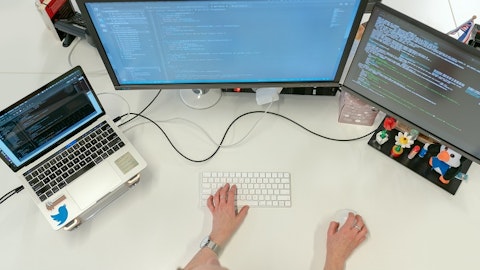Mike Dastoor: And Shannon, our business assumptions continue to be extremely robust. I think I highlighted some of the secular trends that we’re actually participating in. All of those continue to show very decent growth.
Shannon Cross : And then just one other question. How — when you talk to your customers, how are they thinking about geographic distribution of manufacturing these days? Given the challenges in China, I know it’s starting to open up again, but obviously, it comes and goes, I’m wondering how much of a discussion customers are having about Eastern Europe and India. And obviously, you’re pretty well positioned to help them as they move production around. Thank you and happy holidays to all of you as well.
Mark Mondello : Thank you. Happy holidays to you too. I don’t know that there’s a general theme. I think we have 400-plus customers, and I think our customers’ thoughts are all over the map, and they’re doing the best for their business based on their products. Everything — and this will give you a little bit of a feel for the complexity of it. And by the way, it’s why our structure is so efficient and so optimal in terms of customer solutions. Here at Jabil, we don’t run our business on a factory basis. We run it customer by customer, line item by line item. And the reason we do that is let’s just take a product that, let’s say, the unit cost is x, but the ability to move that product around the world in terms of distributing the product is very expensive.
Well, that would suggest maybe we build it in-region. We have other products that cost y and moving that product around the world is very small relative to the cost of the product, and we might consolidate that to a single spot in the world. Then you add to it, all the different geopolitical issues, the very unfortunate issue that continues to wane on in the Ukraine. So it’s hard for me to go, geez, this is kind of the herd mentality of our customers because the business just doesn’t act that way. Also, I would suggest that when you look at our portfolio, and you look at the eight sectors that we define and then you think about all the subsectors of the business, Again, one of the things I think is a huge strength at Jabil is the diversification.
And with that diversification becomes endless amounts of solutions. And again, I take you back to our approach and our structure. We kind of work with each customer in a very unique way, accommodating their needs. With that being said, I would say that you’ll probably see us do some expansion in Eastern Europe. You’ll probably see us continue to expand in Mexico. I think we feel pretty good about our footprint in China. And you’ll probably see some expansion over the next couple of years in India.
Operator: Our next question is coming from the line of Matt Sheerin with Stifel.
Matt Sheerin : I have a question, Mark, regarding your updated revenue guidance for FY ’23. You’re raising the outlook for auto and healthcare. Is that related to just better supply conditions or demand related? Why taking that number up — taking those numbers up?
Mark Mondello: We’re taking them up because we can. I mean, as we sit here today, one could look at it and go, why would you guys take the numbers up, if you’re somewhat cautious about the back half of the year or gosh knows what’s going to happen in ’23 based on what the U.S. Fed is doing in the markets, et cetera, et cetera. But I think we use very good judgment. Again, a real good charm about Jabil is we break our business up into really, really, really small pieces. And it gives us really good acuity, high resolution of all elements of our business. So in a more general sense, I think the — again, referring back to one of the slides that one of us spoke to is we’re — as we sit today, we’re going to — we think we’ll see double-digit growth in the areas of auto and transportation largely driven by EVs. Healthcare, I think we showed on the slide would be maybe north of 10%, and then same with our industrial semi cap business largely being led on the industrial side.
And the growth in all three of those areas, A, supply chain is getting better and getting better faster. One caveat there is, is legacy semiconductors in the EV space are still tight. But supply chain is getting markedly better. Our ability to gather parts relative to others is very strong. And then in certain aspects of those, based on certain trends, demand is holding reasonably well.
Matt Sheerin : And then a question, Mike, regarding the incremental consignment revenue that you talked about. So total $800 million in revenue going to consignment for your cloud customer. Does that move the needle on gross margin at all? Is there any change in terms of the operating margin or operating income on that business?
Mike Dastoor: So yes, it does move the needle a little bit on margin, but there’s been some offsets. I think Adam highlighted some inefficiencies that we had on the mobility side in China, particularly in Q1. We’ve made some assumptions around further COVID, et cetera, as well in parts of the world, and that does have a little bit of an impact on margin. But you’re right, on the consigned side, it has a small margin improvement impact. And that’s one of the reasons we pursue this with — along with the customer.
Mark Mondello : If I could add to that, here’s a real simple way to think about it in very round numbers. Two years ago, the overall op margin for the company was 4.2%. Last year, it was 4.6%. This year, at the beginning of the year, we suggested that the op margin for the year will be 4.8%. We’re holding to that 4.8%, which we’re proud of. So there’s a 20 bps expansion between ’22 and ’23. About half of that is based on our cost management for the back half of the year as well as continuing to advance our asset-light nature of our cloud business and the other half of that is the lack of a better word, the core business. But what’s interesting is, I don’t even like differentiating that because for me, all of this activity goes hand in hand with running a good business. So — but in terms of your modeling and the way to think about it, I think that’s a reasonable way to think about it.
Operator: Our next question is coming from the line of Ruplu Bhattacharya with Bank of America.





